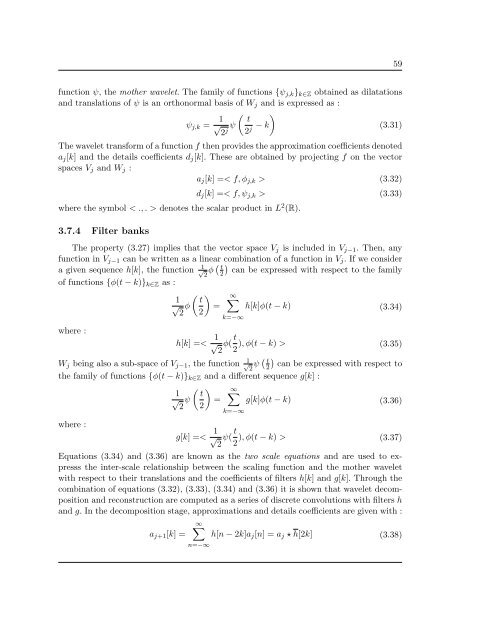Th`ese Marouan BOUALI - Sites personnels de TELECOM ParisTech
Th`ese Marouan BOUALI - Sites personnels de TELECOM ParisTech
Th`ese Marouan BOUALI - Sites personnels de TELECOM ParisTech
You also want an ePaper? Increase the reach of your titles
YUMPU automatically turns print PDFs into web optimized ePapers that Google loves.
59<br />
function ψ, the mother wavelet. The family of functions {ψ j,k } k∈Z obtained as dilatations<br />
and translations of ψ is an orthonormal basis of W j and is expressed as :<br />
ψ j,k = √ 1 ( ) t<br />
ψ<br />
2 j 2 j − k (3.31)<br />
The wavelet transform of a function f then provi<strong>de</strong>s the approximation coefficients <strong>de</strong>noted<br />
a j [k] and the <strong>de</strong>tails coefficients d j [k]. These are obtained by projecting f on the vector<br />
spaces V j and W j :<br />
a j [k] =< f, φ j,k > (3.32)<br />
d j [k] =< f, ψ j,k > (3.33)<br />
where the symbol < ., . > <strong>de</strong>notes the scalar product in L 2 (R).<br />
3.7.4 Filter banks<br />
The property (3.27) implies that the vector space V j is inclu<strong>de</strong>d in V j−1 . Then, any<br />
function in V j−1 can be written as a linear combination of a function in V j . If we consi<strong>de</strong>r<br />
a given sequence h[k], the function √ 1<br />
2<br />
φ ( t<br />
2)<br />
can be expressed with respect to the family<br />
of functions {φ(t − k)} k∈Z as :<br />
(<br />
1 t<br />
∞∑<br />
√ φ = h[k]φ(t − k) (3.34)<br />
2 2)<br />
where :<br />
k=−∞<br />
h[k] =< √ 1 φ( t ),φ(t − k) > (3.35)<br />
2 2<br />
W j being also a sub-space of V j−1 , the function √ 1<br />
2<br />
ψ ( t<br />
2)<br />
can be expressed with respect to<br />
the family of functions {φ(t − k)} k∈Z and a different sequence g[k] :<br />
where :<br />
1<br />
√<br />
2<br />
ψ<br />
( t<br />
=<br />
2)<br />
∞∑<br />
k=−∞<br />
g[k]φ(t − k) (3.36)<br />
g[k] =< √ 1 ψ( t ),φ(t − k) > (3.37)<br />
2 2<br />
Equations (3.34) and (3.36) are known as the two scale equations and are used to expresss<br />
the inter-scale relationship between the scaling function and the mother wavelet<br />
with respect to their translations and the coefficients of filters h[k] and g[k]. Through the<br />
combination of equations (3.32), (3.33), (3.34) and (3.36) it is shown that wavelet <strong>de</strong>composition<br />
and reconstruction are computed as a series of discrete convolutions with filters h<br />
and g. In the <strong>de</strong>composition stage, approximations and <strong>de</strong>tails coefficients are given with :<br />
∞∑<br />
a j+1 [k] = h[n − 2k]a j [n] =a j ⋆ h[2k] (3.38)<br />
n=−∞















